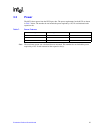
28 Evaluation Platform Board Manual
Intel
®
IQ80332 I/O Processor
Hardware Reference Section
3.4 Memory Subsystem
The Memory Controller of 80332 controls the DDR SDRAM memory subsystem. It features pro-
grammable chip selects and support for error correction codes (ECC). The memory controller can
be configured for DDR SDRAM at 333 MHz and DDR-II at 400 MHz. The memory controller
supports pipelined access and arbitration control to maximize performance. The memory controller
interface configuration support includes Unbuffered DIMMs, Registered DIMMs, and discrete
DDR SDRAM devices.
This IQ80332 has DDR-II at 400 MHz DIMM on the board. The memory subsystem of the
evaluation board consists of the SDRAM as well as the Flash memory subsystems.
3.4.1 DDR SDRAM
The DDR SDRAM interface consists of a 64-bit wide data path to support up to 3.2 Gbytes/sec
throughput. An 8-bit Error Correction Code (ECC) is stored into the DDRII SDRAM array along
with the data and is checked when the data is read.
The IQ80332 features on board registered DDRII 400 MHz SDRAM, arranged 512 Mbit x16 in
density (256 MB), and with ECC.
3.4.1.1 Battery Backup
Battery backup is provided to save any information in DDR during a power failure. The evaluation
board contains a 4V Li-ion battery, a charging circuit and a regulator circuit.
DDRII technology provides enabling data preservation through the self-refresh command. When the
processor receives an active Primary PCI-X reset, the self-refresh command issues, driving SCKE
signals low. Upon seeing this condition, the board logic circuit holds SCKE low before the processor
loses power. Batteries maintain power to DDRII and logic, to ensure self-refresh mode. When the
circuit detects PRST# returning to inactive state, the circuit releases the hold on SCKE. Removing the
battery can disable the battery circuit. When the battery remains in the platform when it is de-powered
and/or removed from the chassis, the battery maintains DDRII for about four hours. Once power is
reapplied, the battery is fully charged.
The CPLD contains information in regards to the battery status. Please see Section 3.6.7, “Battery
Status” on page 34 for more details.


















